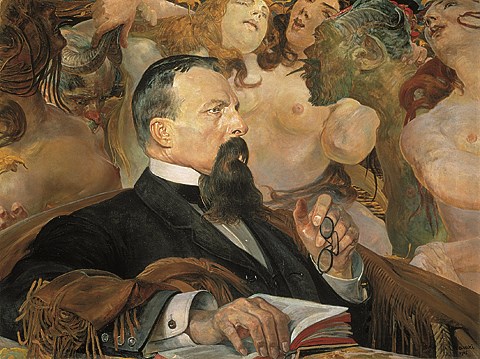Description:
Jack Malczewski (1854-1929) held a deep love for art and romantic literature, especially the poetry of Julius Słowacki, which he had inherited from his family. He was from a noble, albeit impoverished, background. His father, Julian, supported him on his journey in his painting career. The events of 1863, the January Uprising and subsequent repressions, had a profound effect on the young artist. His first teacher was Adolf Dygasiński. His youth from 1867-1871 was spent in his uncle’s manor in Wielgiem. In 1873, he began studying at the School of Fine Arts in Krakow under the tutelage of Jan Matejko. He was a student of Władysław Łuszczkiewicz and he also studied at the École des Beaux-Arts in Paris. He traveled to Italy, Vienna, Munich, Greece, and Asia Minor. From 1896-1900 and 1910-1914, he was a professor at the Academy of Fine Arts in Krakow. In 1912-1914, he was its rector. He began with idealizing realism and then moved on to naturalistic styles. During this period, his works were mainly focused on the plight of exiles to Siberia and Julius Słowacki’s “Anhellim”. At the same time, fantastical and allegorical elements began to appear in his works. After his father’s death in 1884, the theme of Thanatos – the god of death – became a recurring motif in Malczewski’s works. After 1890, his art became wholly symbolic. Works that demonstrated this shift to a symbolist style were “Introduction” (1890), “Melancholy” (1890-1894), and “The Misfortunate Wheel” (1895-1897). The artist explored existential, historical, and artistic topics, melding together ancient and biblical motifs with native folklore and the ever-present Polish landscape. His form, color, monumentalism, and expressiveness became his signature trademarks.
Description of the painting:
Jack Malczewski and Edward Aleksander Raczyński knew each other already in 1892. During the creation of the portrait in the Rogalin collections, there were around seventeen works of the Polish Symbolist*. Was it only fascination with the work, or also with the artistic personality of Malczewski? It is certain that the painter was a frequent guest in the Raczyński palace. He also captured the surroundings and inhabitants several times. The image of Edward Aleksander is considered one of the best portraits made by the artist*. It presents the count as a lover of art and a connoisseur of female beauty in the company of three ancient Graces and satyrs.
Edward Aleksander Raczyński was portrayed as a middle-aged man wearing a dark suit, sitting in a wicker chair. In his left hand he holds a cigar. He held it in a rather nonchalant way, giving the impression of slipping between his fingers. Captured in the moment, after reading a captivating Raczyński fragment of a book probably about art. His left hand holds the pages of an open volume. Edward Alexander’s gaze was directed to the right, giving himself to musings.
The image of the distinguished collector is complemented, by way of contrast, by an incredibly dynamic background of the presentation. Three naked, young women writhing in ecstatic frenzy: a blonde, a brunette and a redhead. Between them, imaginary figures – satyrs and an image reminiscent of the mythical Medusa. As for the symbolism of the fauna, you can read the description of the work “Satyr / Painter” / “Portrait of Zefiryn Bielecki”. What hidden meanings carry the appearing female figures?
On the left side of the work, at its edge, the artist placed the image of a woman with thin strands of hair winding around her face. The open mouth in a grimace of pain is a motif often appearing in the representations of the youngest of the Gorgons. In Medusa, it was often seen as a prototype of the modern ‘femme fatale’ who could kill with her eyes. However, the one painted by Jacek Malczewski has her eyes closed. She has been deprived of her only weapon. She is surrounded by a group of three naked women. They are the ones who tempt and lead astray. The three painted women can be identified with the three mythical Graces – Charites. They are goddesses of grace and joy, whose task was to beautify people’s lives. Patrons of art. They brought comfort and fun. They are considered companions of Dionysus and Apollo. Their beauty attracted the susceptible to female charms.
In the work of Malczewski, the female gender completely reversed the order. “Medusa” does not look menacingly, the faun does not play the flute. His goat horns are no longer threatening. He completely submits to the will of the surrounding women, letting himself be led. Unbridled instincts, tempting beauty of a female body and sexualization of the presented figures have dominated the background of the portrait of Edward Aleksander Raczyński. Although posing, full of gravity, he seems to pay no attention to them. However, they completely conquered his senses, as a result they became one of the main topics of the works collected by him. They subordinated his life to art, making the illustrious its benefactor balance between two worlds: the one emerging from artistic imagination and the real one, full of aesthetic and moral dissonances.


